Abstract
The effects of feeding different levels of milk to diarrheic calves (n = 19) supplemented with oral electrolytes were investigated. In the early stages of the disease the calves were fed either enough milk to maintain normal growth in a healthy calf, one half that volume or no milk. The three groups were further subdivided according to whether or not the electrolyte solution contained bicarbonate. A full milk ration allowed uninterrupted weight gains of 1% body weight/day (p = 0.003), but caused greater inappetence (p = 0.003 to 0.037) at the beginning of the trial than lower levels of milk intake. Electrolyte solutions with bicarbonate reduced growth rates in milk fed calves (p = 0.014). The density of fat stores increased with the level of milk feeding (p = 0.04 to 0.053). The mitotic index of the duodenal mucosa increased with milk feeding (p = 0.08), indicating a superior mucosal regeneration potential. Thymic atrophy was pronounced in those calves fed no milk (p = 0.001). It was concluded that the continued feeding of milk to diarrheic calves was beneficial. Electrolyte solutions containing bicarbonate should be avoided when milk is fed to diarrheic calves.
Full text
PDF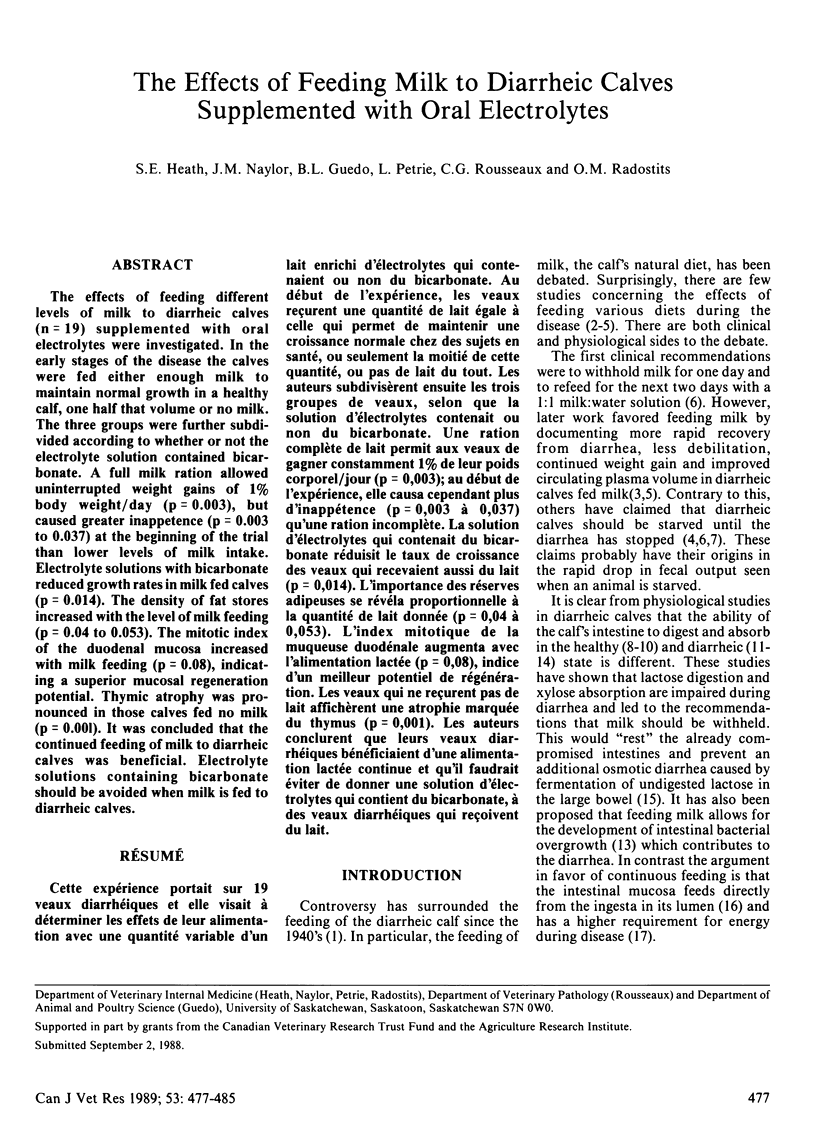
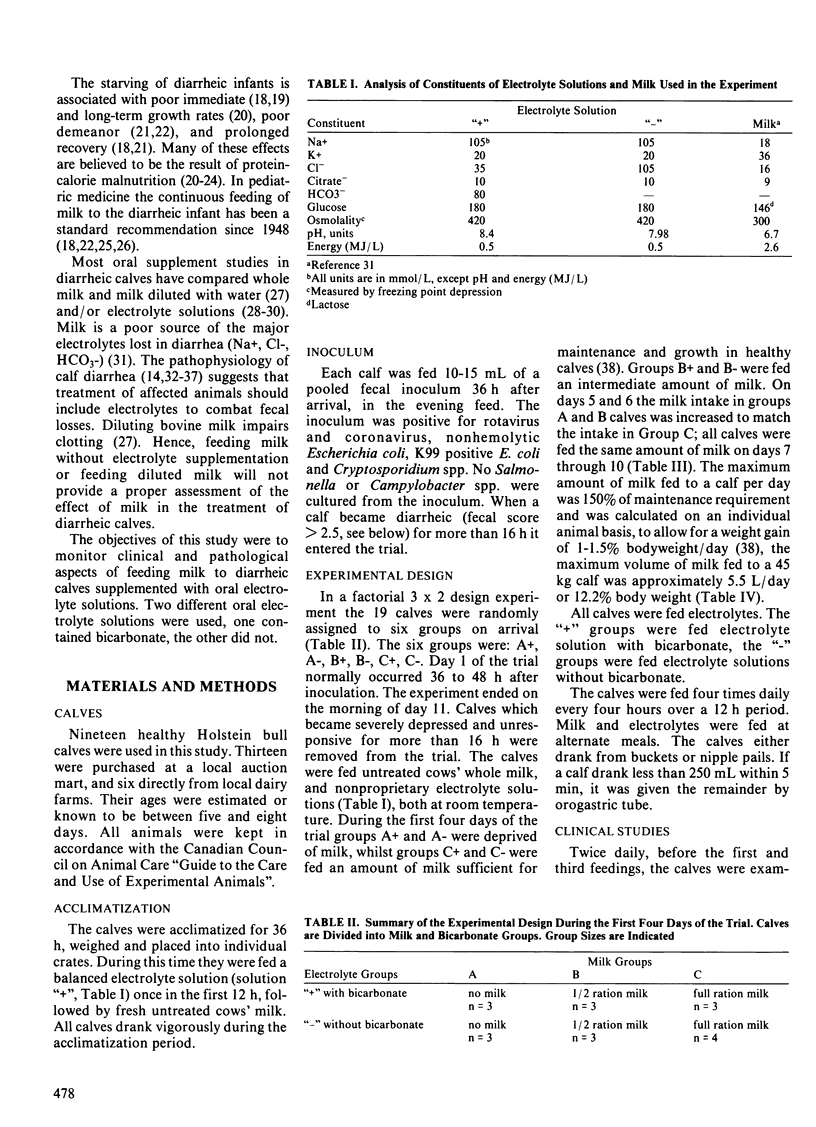
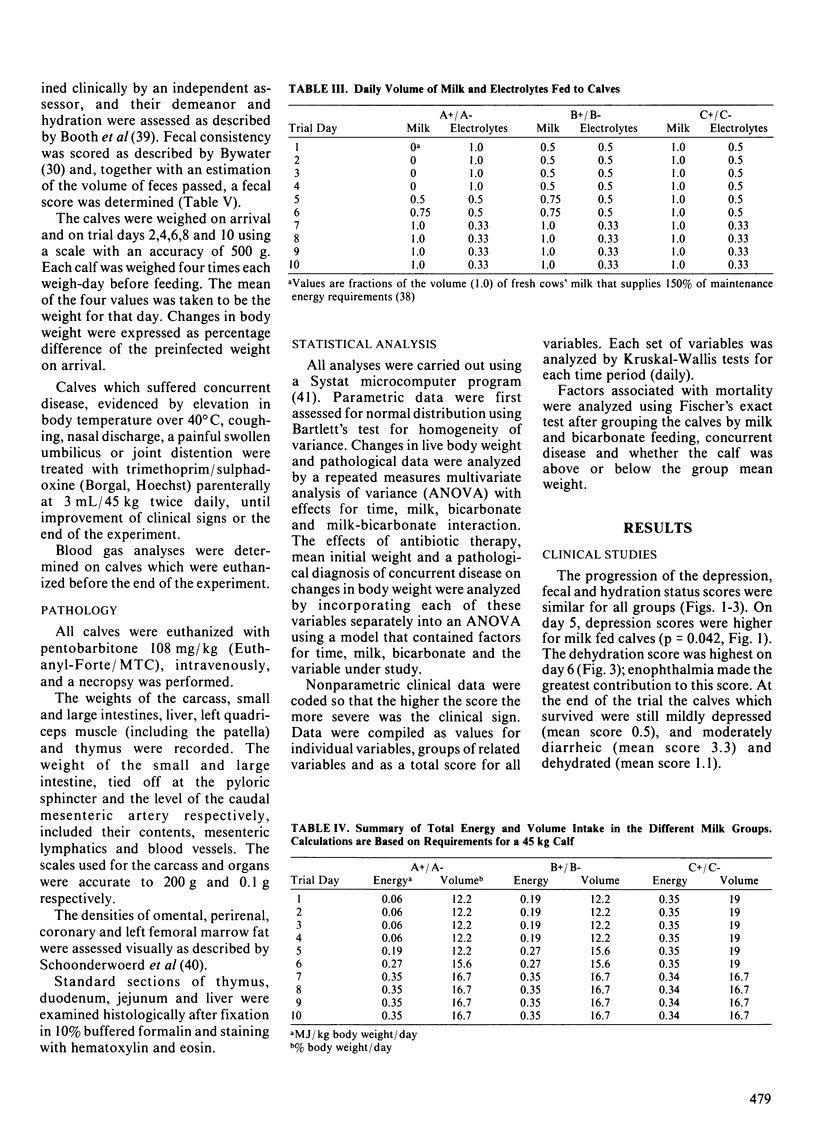
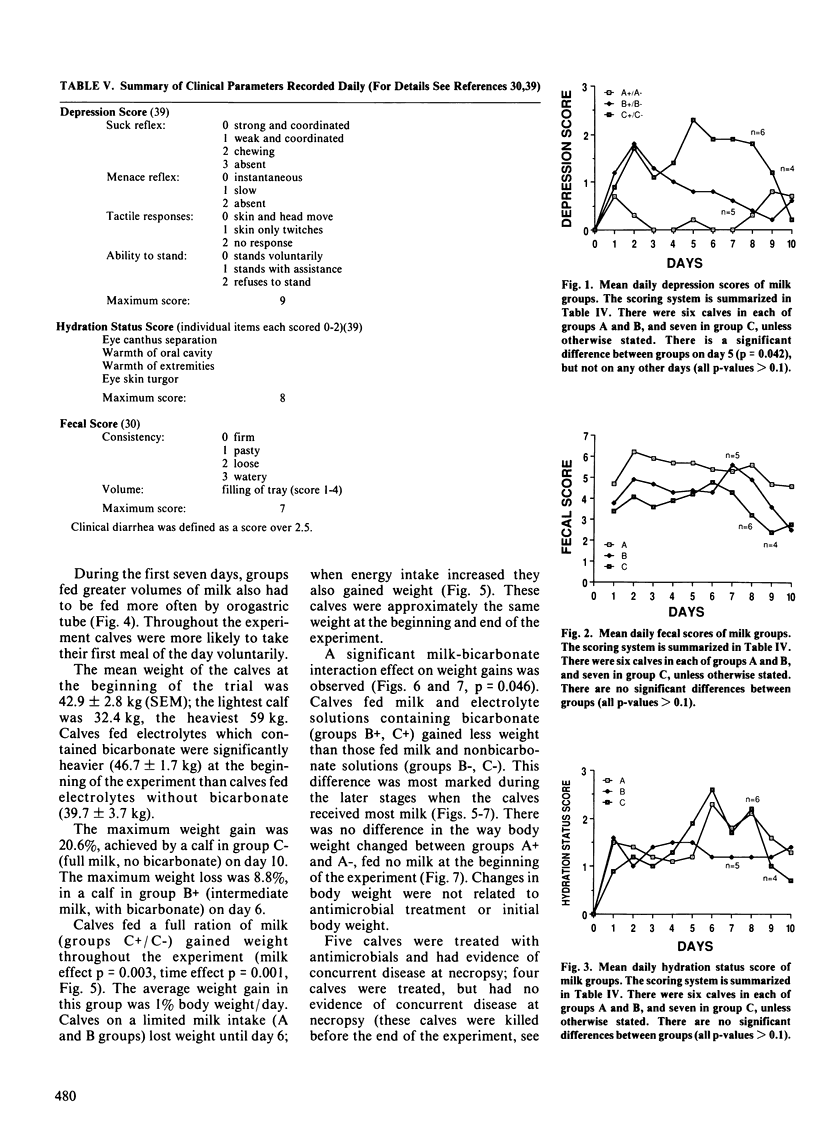
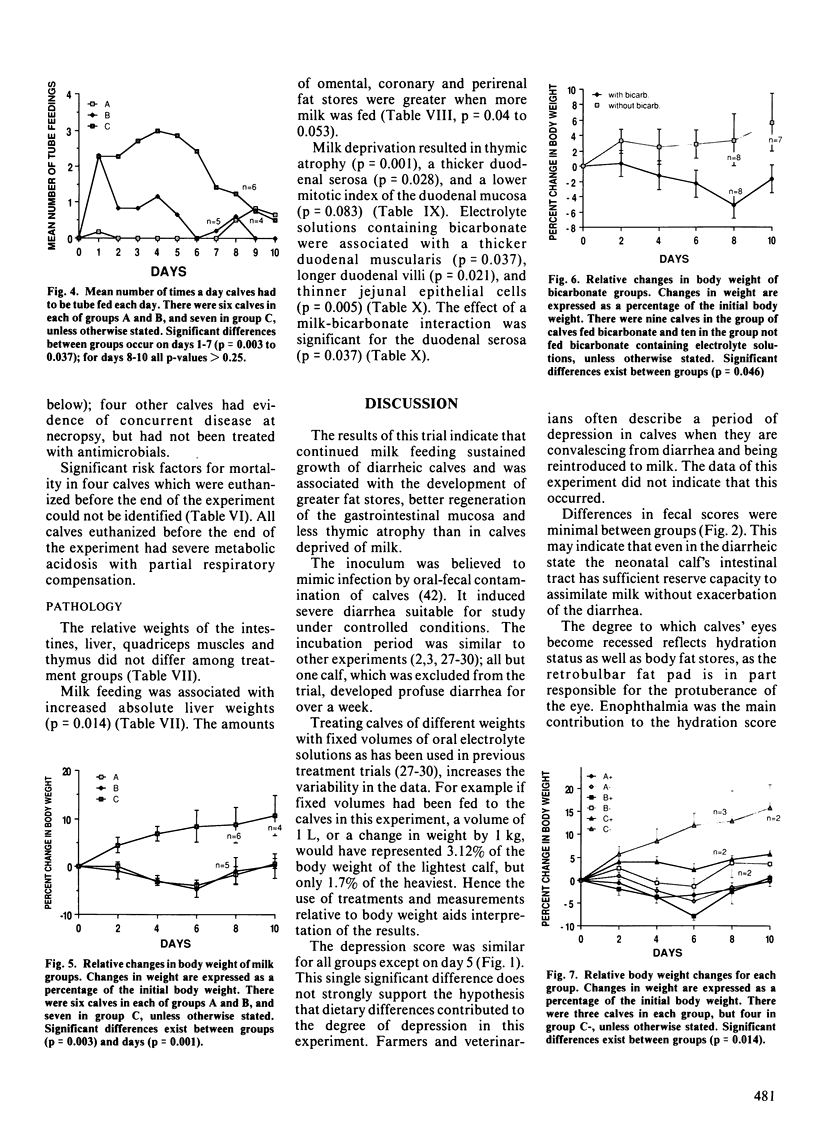
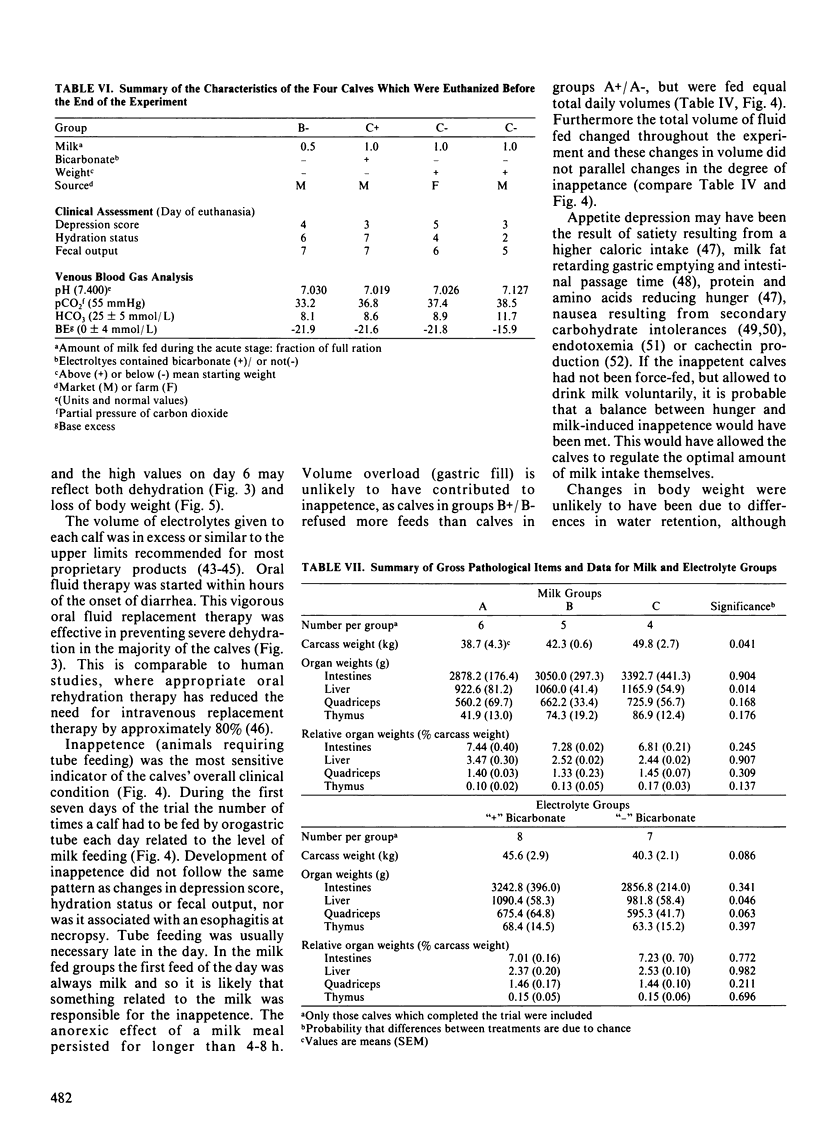
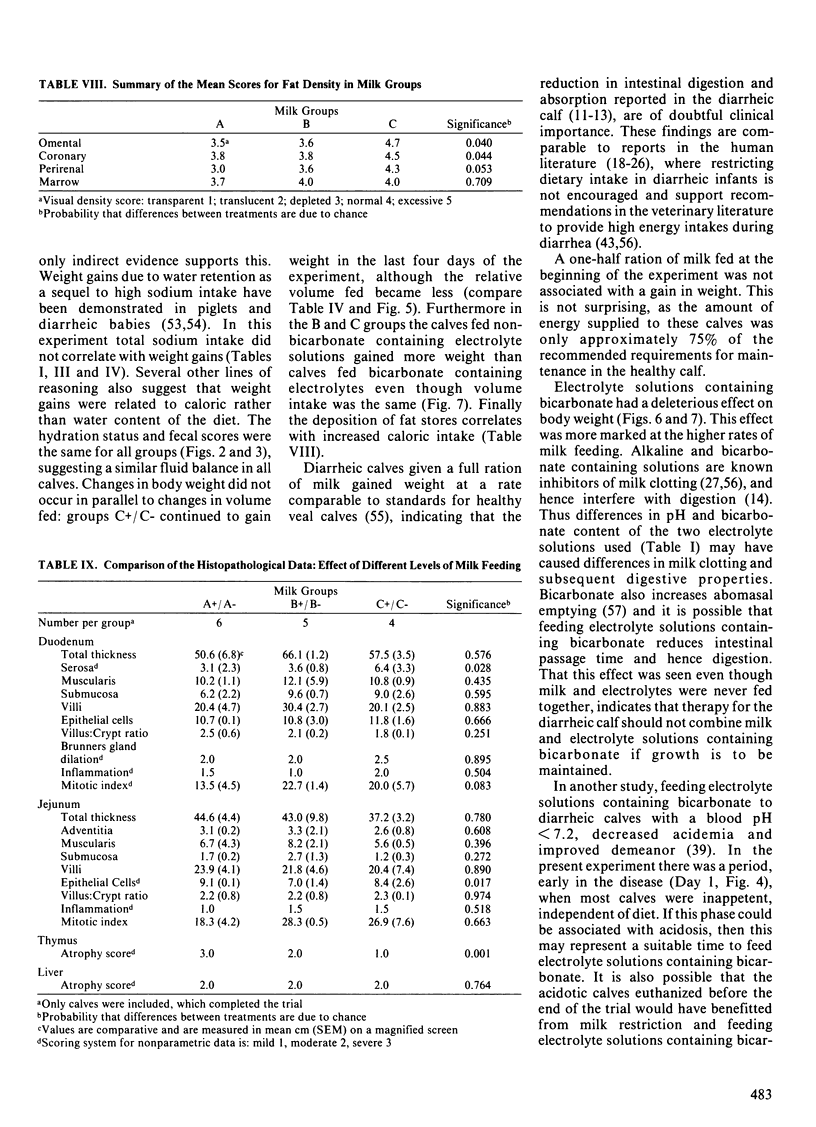
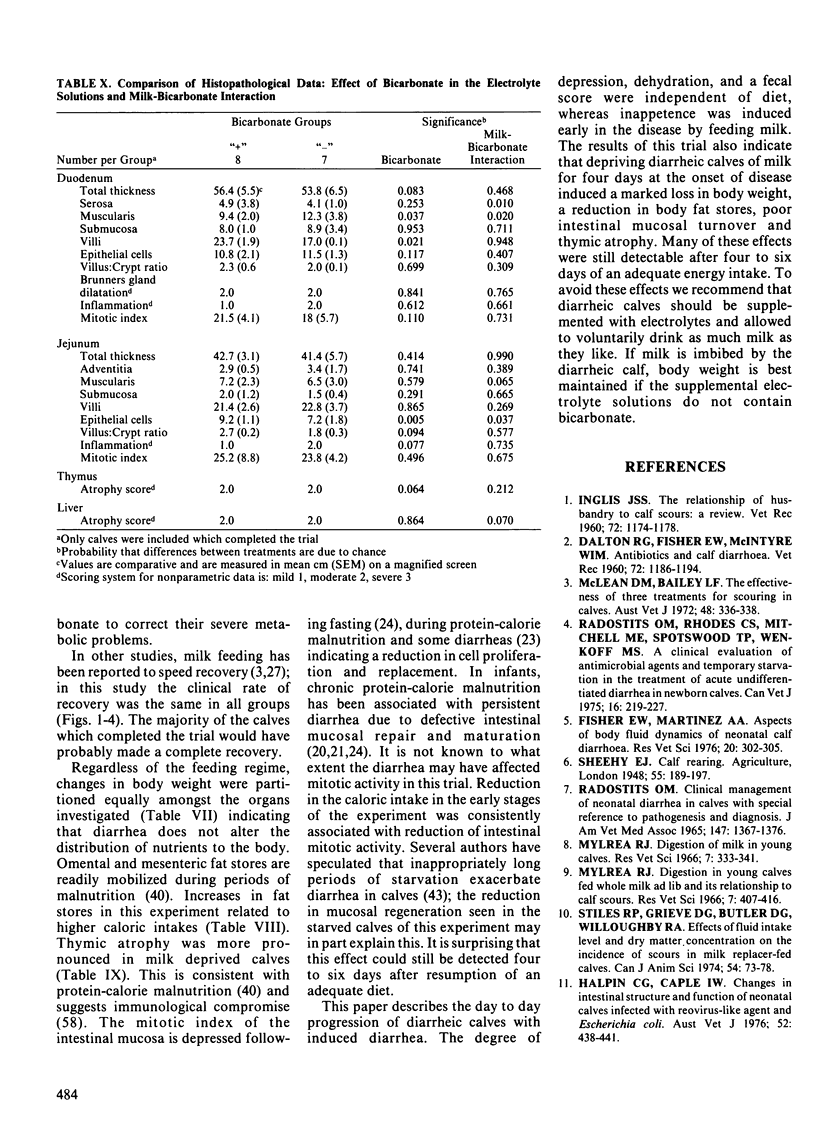
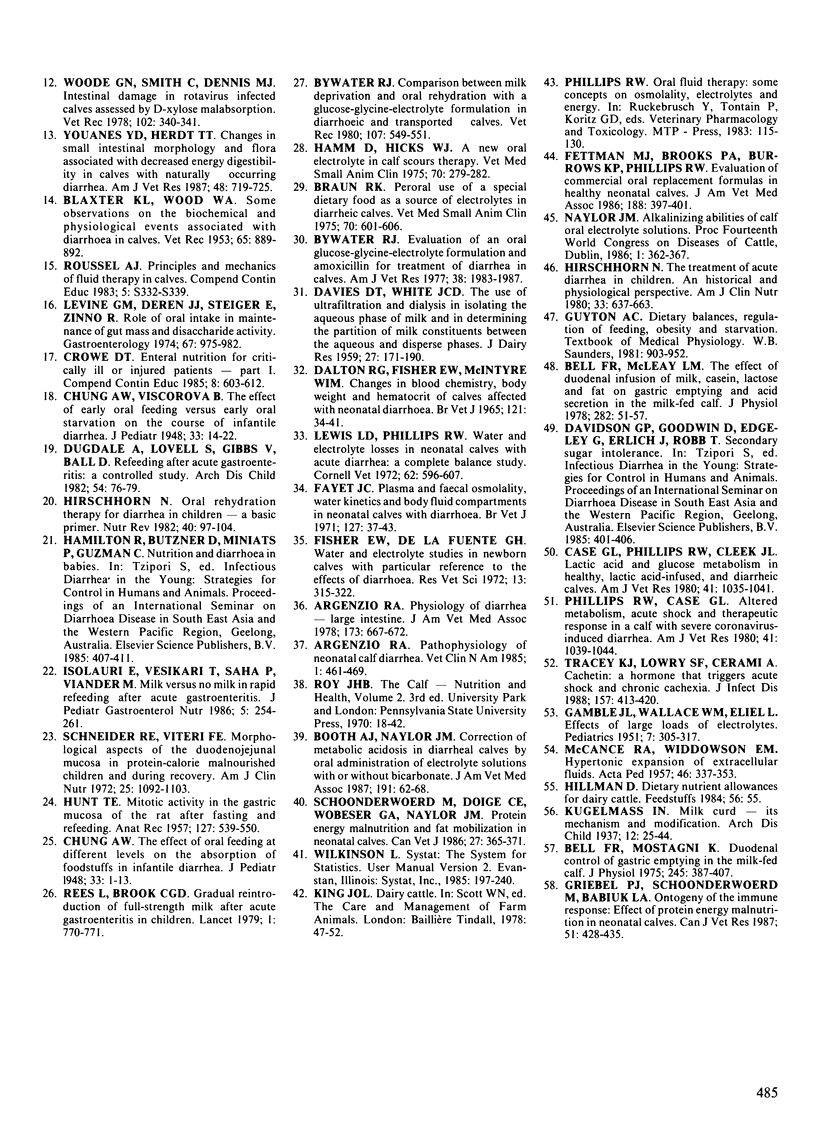
Selected References
These references are in PubMed. This may not be the complete list of references from this article.
- Argenzio R. A. Pathophysiology of neonatal calf diarrhea. Vet Clin North Am Food Anim Pract. 1985 Nov;1(3):461–469. doi: 10.1016/s0749-0720(15)31296-2. [DOI] [PubMed] [Google Scholar]
- Argenzio R. A. Physiology of diarrhea--large intestine. J Am Vet Med Assoc. 1978 Sep 1;173(5 Pt 2):667–672. [PubMed] [Google Scholar]
- Bell F. R., McLeay L. M. The effect of duodenal infusion of milk, casein, lactose and fat on gastric emptying and acid secretion in the milk-fed calf. J Physiol. 1978 Sep;282:51–57. doi: 10.1113/jphysiol.1978.sp012447. [DOI] [PMC free article] [PubMed] [Google Scholar]
- Bell F. R., Mostaghni K. Duodenal control of gastric emptying in the milk-fed calf. J Physiol. 1975 Feb;245(2):387–407. doi: 10.1113/jphysiol.1975.sp010852. [DOI] [PMC free article] [PubMed] [Google Scholar]
- Booth A. J., Naylor J. M. Correction of metabolic acidosis in diarrheal calves by oral administration of electrolyte solutions with or without bicarbonate. J Am Vet Med Assoc. 1987 Jul 1;191(1):62–68. [PubMed] [Google Scholar]
- Braun R. K. Peroral use of a special dietary food as a source of electrolytes in diarrheic calves. Vet Med Small Anim Clin. 1975 May;70(5):601–606. [PubMed] [Google Scholar]
- Bywater R. J. Comparison between milk deprivation and oral rehydration with a glucose-glycine-electrolyte formulation in diarrhoeic and transported calves. Vet Rec. 1980 Dec 13;107(24):549–551. [PubMed] [Google Scholar]
- Bywater R. J. Evaluation of an oral glucose-glycine-electrolyte formulation and amoxicillin for treatment of diarrhea in calves. Am J Vet Res. 1977 Dec;38(12):1983–1987. [PubMed] [Google Scholar]
- Case G. L., Phillips R. W., Cleek J. L. Lactic acid and glucose metabolism in healthy, lactic acid-infused, and diarrheic calves. Am J Vet Res. 1980 Jul;41(7):1035–1038. [PubMed] [Google Scholar]
- DALTON R. G., FISHER E. W., MCINTYRE W. I. CHANGES IN BLOOD CHEMISTRY, BODY WEIGHT AND HAEMOTOCRIT OF CALVES AFFECTED WITH NEONATAL DIARRHOEA. Br Vet J. 1965 Jan;121:34–42. doi: 10.1016/s0007-1935(17)41405-9. [DOI] [PubMed] [Google Scholar]
- Dugdale A., Lovell S., Gibbs V., Ball D. Refeeding after acute gastroenteritis: a controlled study. Arch Dis Child. 1982 Jan;57(1):76–78. [PMC free article] [PubMed] [Google Scholar]
- Fayet J. C. Plasma and faecal osmolality, water kinetics and body fluid compartments in neonatal calves with diarrhoea. Br Vet J. 1971 Jan;127(1):37–44. doi: 10.1016/s0007-1935(17)37787-4. [DOI] [PubMed] [Google Scholar]
- Fettman M. J., Brooks P. A., Burrows K. P., Phillips R. W. Evaluation of commercial oral replacement formulas in healthy neonatal calves. J Am Vet Med Assoc. 1986 Feb 15;188(4):397–401. [PubMed] [Google Scholar]
- Fisher E. W., De la Fuente G. H. Water and electrolyte studies in newborn calves with particular reference to the effects of diarrhoea. Res Vet Sci. 1972 Jul;13(4):315–322. [PubMed] [Google Scholar]
- Fisher E. W., Martinez A. A. Aspects of body fluid dynam1cs of neonatal calf diarrhoea. Res Vet Sci. 1976 May;20(3):302–305. [PubMed] [Google Scholar]
- GAMBLE J. L., WALLACE W. M., ELIEL L., HOLLIDAY M. A., CUSHAMN M., APPLETON J., SHENBERG A., PIOTTI J. Effects of large loads of electrolytes. Pediatrics. 1951 Mar;7(3):305–330. [PubMed] [Google Scholar]
- Griebel P. J., Schoonderwoerd M., Babiuk L. A. Ontogeny of the immune response: effect of protein energy malnutrition in neonatal calves. Can J Vet Res. 1987 Oct;51(4):428–435. [PMC free article] [PubMed] [Google Scholar]
- HUNT T. E. Mitotic activity in the gastric mucosa of the rat after fasting and refeeding. Anat Rec. 1957 Mar;127(3):539–550. doi: 10.1002/ar.1091270305. [DOI] [PubMed] [Google Scholar]
- Halpin C. G., Caple I. W. Changes in intestinal structure and function of neonatal calves infected with reovirus-like agent and Eschericia coli. Aust Vet J. 1976 Oct;52(10):438–441. doi: 10.1111/j.1751-0813.1976.tb05384.x. [DOI] [PubMed] [Google Scholar]
- Hamm D., Hicks W. J. A new oral electrolyte in calf scours therapy. Vet Med Small Anim Clin. 1975 Mar;70(3):279–282. [PubMed] [Google Scholar]
- Hirschhorn N. Oral rehydration therapy for diarrhea in children--a basic primer. Nutr Rev. 1982 Apr;40(4):97–104. doi: 10.1111/j.1753-4887.1982.tb05279.x. [DOI] [PubMed] [Google Scholar]
- Hirschhorn N. The treatment of acute diarrhea in children. An historical and physiological perspective. Am J Clin Nutr. 1980 Mar;33(3):637–663. doi: 10.1093/ajcn/33.3.637. [DOI] [PubMed] [Google Scholar]
- Isolauri E., Vesikari T., Saha P., Viander M. Milk versus no milk in rapid refeeding after acute gastroenteritis. J Pediatr Gastroenterol Nutr. 1986 Mar-Apr;5(2):254–261. [PubMed] [Google Scholar]
- Levine G. M., Deren J. J., Steiger E., Zinno R. Role of oral intake in maintenance of gut mass and disaccharide activity. Gastroenterology. 1974 Nov;67(5):975–982. [PubMed] [Google Scholar]
- Lewis L. D., Phillips R. W. Water and electrolyte losses in neonatal calves with acute diarrhea. A complete balance study. Cornell Vet. 1972 Oct;62(4):596–607. [PubMed] [Google Scholar]
- McCANCE R. A., WIDDOWSON E. M. Hypertonic expansion of the extracellular fluids. Acta Paediatr. 1957 Jul;46(4):337–353. doi: 10.1111/j.1651-2227.1957.tb14476.x. [DOI] [PubMed] [Google Scholar]
- McLean D. M., Bailey L. F. The effectiveness of three treatments for scouring in calves. Aust Vet J. 1972 Jun;48(6):336–338. doi: 10.1111/j.1751-0813.1972.tb02262.x. [DOI] [PubMed] [Google Scholar]
- Mylrea P. J. Digestion in young calves fed whole milk ad lib. and its relationship to calf scours. Res Vet Sci. 1966 Oct;7(4):407–416. [PubMed] [Google Scholar]
- Mylrea P. J. Digestion of milk in young calves. I. Flow and acidity of the contents of the small intestine. Res Vet Sci. 1966 Jul;7(3):333–341. [PubMed] [Google Scholar]
- Phillips R. W., Case G. L. Altered metabolism, acute shock, and therapeutic response in a calf with severe coronavirus-induced diarrhea. Am J Vet Res. 1980 Jul;41(7):1039–1044. [PubMed] [Google Scholar]
- Radostits O. M. Clinical management of neonatal diarrhea in calves, with special reference to pathogenesis and diagnosis. J Am Vet Med Assoc. 1965 Dec 15;147(12):1367–1376. [PubMed] [Google Scholar]
- Radostits O. M., Rhodes C. S., Mitchell M. E., Spotswood T. P., Wenkoff M. S. A clinical evaluation of antimicrobial agents and temporary starvation in the treatment of acute undifferentiated diarrhea in newborn calves. Can Vet J. 1975 Aug;16(8):219–227. [PMC free article] [PubMed] [Google Scholar]
- Rees L., Brook C. G. Gradual reintroduction of full-strength milk after acute gastroenteritis in children. Lancet. 1979 Apr 7;1(8119):770–771. doi: 10.1016/s0140-6736(79)91220-0. [DOI] [PubMed] [Google Scholar]
- Schneider R. E., Viteri F. E. Morphological aspects of the duodenojejunal mucosa in protein--calorie malnourished children and during recovery. Am J Clin Nutr. 1972 Oct;25(10):1092–1102. doi: 10.1093/ajcn/25.10.1092. [DOI] [PubMed] [Google Scholar]
- Schoonderwoerd M., Doige C. E., Wobeser G. A., Naylor J. M. Protein energy malnutrition and fat mobilization in neonatal calves. Can Vet J. 1986 Oct;27(10):365–371. [PMC free article] [PubMed] [Google Scholar]
- Tracey K. J., Lowry S. F., Cerami A. Cachectin: a hormone that triggers acute shock and chronic cachexia. J Infect Dis. 1988 Mar;157(3):413–420. doi: 10.1093/infdis/157.3.413. [DOI] [PubMed] [Google Scholar]
- Woode G. N., Smith C., Dennis M. J. Intestinal damage in rotavirus infected calves assessed by D-xylose malabsorption. Vet Rec. 1978 Apr 15;102(15):340–341. doi: 10.1136/vr.102.15.340-a. [DOI] [PubMed] [Google Scholar]
- Youanes Y. D., Herdt T. H. Changes in small intestinal morphology and flora associated with decreased energy digestibility in calves with naturally occurring diarrhea. Am J Vet Res. 1987 Apr;48(4):719–725. [PubMed] [Google Scholar]


